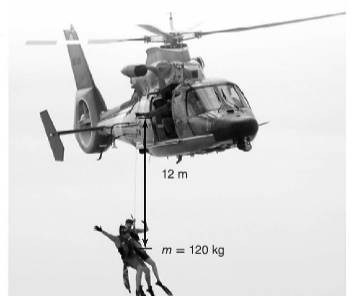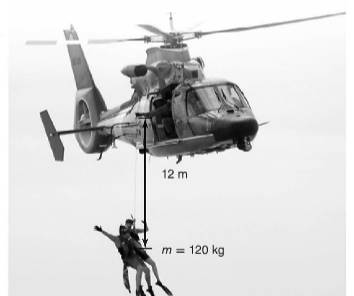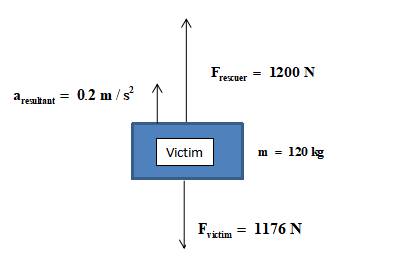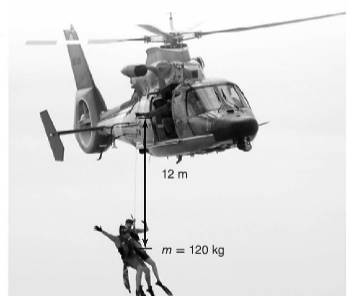
Concept explainers
(a)
Maximum mass that a winch can lift.
(a)
Answer to Problem 51A
Maximum mass a winch can lift is 204.08 kg.
Explanation of Solution
Given:
The given figure is shown below.

Formula used:
According to Newton’s 2nd law, force is given by the formula,
Where,
m is mass of the body
a is acceleration of body
Calculation:
Maximum mass that can be lifted by winch is,
(b)
The rescue’s and victim’s acceleration.
To draw: A free body diagram of the people being lifted.
(b)
Answer to Problem 51A
The acceleration of victim is 9.8 m/s2 and acceleration of rescue is 0.2 m/s2.
A free body diagram of the people being lifted is shown in Figure 1.
Explanation of Solution
Given:
The given figure is shown below.

Calculation:
From part (a), the maximum mass is
Winch force is acting in the upward direction that is along positive y -direction
Mass of victims = 120 kg
Force exerted by the victim is,
The direction of force in the downward direction that is along negative y -direction.
Total force exerted on victim is,
(Considering force along positive y -direction is positive and along negative y -direction is negative)
Positive sign of the force signifies that the resultant force in the direction of positive y- direction.
Acceleration of rescuer is
The free-body diagram is shown below.

Figure 2
(c)
Time taken to pull the people up to the helicopter.
(c)
Answer to Problem 51A
Time taken to pull the people up to the helicopter is 10.95 sec.
Explanation of Solution
Given:
The given figure is shown below.

Initially victims are stationary
Distance between rescue and victim is 12 m.
Rescue’s acceleration is,
Formula used:
The equation of motion is,
Calculation:
Substituting the values in above equation.
Chapter 4 Solutions
Glencoe Physics: Principles and Problems, Student Edition
Additional Science Textbook Solutions
Campbell Biology in Focus (2nd Edition)
Anatomy & Physiology (6th Edition)
Human Physiology: An Integrated Approach (8th Edition)
Physics for Scientists and Engineers: A Strategic Approach, Vol. 1 (Chs 1-21) (4th Edition)
Chemistry & Chemical Reactivity
Genetic Analysis: An Integrated Approach (3rd Edition)
- Pls help ASAParrow_forwardFind the integral expression for the magnetic force on a wire carrying 3.5 amps current on the z axis with length2 meters on end at the origin and the other at z=4. Magnetic field is B = 4(zy+4) i - (z-3) j + 20(x+2)/(z-3) k.Don’t take the integral. Integral should contain only x-y-z as variables not rarrow_forwardPls help ASAParrow_forward
- 9. Light of wavelength 442 nm is sent through a single slit with a width of 884 nm. At what angle does the first dark fringe occur? a. 30.0° b. 45.0° C. 60.0° d. 90.0° 10. Light travels through a single-slit and forms an interference pattern. The spacing of the dark fringes on one side of the pattern is 1.44 cm. What is the width of the central maximum? a. 0.720 cm 1.44 cm b. C. 2.88 cm d. 4.32 cmarrow_forwardPls help ASAParrow_forwardd. when the index of refraction of medium A is equal to the index of refraction of medium B 7. What is the term for the bending of a wave front as it passes an obstacle? a. interference b. reflection C. d. diffraction refraction 8. A ray of light travels from air into a soap film on a layer of glass, as shown right. Which statement about ray 1 is true? a. There is no inversion at either surface. b. There is an inversion the surface between air and soap, but not soap and glass. C. There is no inversion at the surface between air and soap, incident light ray 1 ray 2 ray 3 but there is one at the surface between soap and glass. d. There is an inversion at both surfaces. air = nair 1.00 soap film nfilm = 1.35 glass = nglass 1.50arrow_forward
- A circular wire with radius 0.4 meters in on x-y plane. There is a constant Magnetic field with 14T strengthtowards z-axis. Find the magnitude of the electromotive force and the direction of the current for a) B decreasesto 10T in 5 seconds. B) B is rotated by 45 degrees and the area doubles in 4 seconds.arrow_forwardWrite the expression for the magnetic flux inside a region om x-z plane at y=0 bounded by z=3x z=0 x=5 x=7due to a magnetic field B = f(x,y,z) i +g(x,y,z) j + h(x,y,z) karrow_forwardExplain mutual inductance of two loops facing one another and compare with one loop inside the other.arrow_forward
 College PhysicsPhysicsISBN:9781305952300Author:Raymond A. Serway, Chris VuillePublisher:Cengage Learning
College PhysicsPhysicsISBN:9781305952300Author:Raymond A. Serway, Chris VuillePublisher:Cengage Learning University Physics (14th Edition)PhysicsISBN:9780133969290Author:Hugh D. Young, Roger A. FreedmanPublisher:PEARSON
University Physics (14th Edition)PhysicsISBN:9780133969290Author:Hugh D. Young, Roger A. FreedmanPublisher:PEARSON Introduction To Quantum MechanicsPhysicsISBN:9781107189638Author:Griffiths, David J., Schroeter, Darrell F.Publisher:Cambridge University Press
Introduction To Quantum MechanicsPhysicsISBN:9781107189638Author:Griffiths, David J., Schroeter, Darrell F.Publisher:Cambridge University Press Physics for Scientists and EngineersPhysicsISBN:9781337553278Author:Raymond A. Serway, John W. JewettPublisher:Cengage Learning
Physics for Scientists and EngineersPhysicsISBN:9781337553278Author:Raymond A. Serway, John W. JewettPublisher:Cengage Learning Lecture- Tutorials for Introductory AstronomyPhysicsISBN:9780321820464Author:Edward E. Prather, Tim P. Slater, Jeff P. Adams, Gina BrissendenPublisher:Addison-Wesley
Lecture- Tutorials for Introductory AstronomyPhysicsISBN:9780321820464Author:Edward E. Prather, Tim P. Slater, Jeff P. Adams, Gina BrissendenPublisher:Addison-Wesley College Physics: A Strategic Approach (4th Editio...PhysicsISBN:9780134609034Author:Randall D. Knight (Professor Emeritus), Brian Jones, Stuart FieldPublisher:PEARSON
College Physics: A Strategic Approach (4th Editio...PhysicsISBN:9780134609034Author:Randall D. Knight (Professor Emeritus), Brian Jones, Stuart FieldPublisher:PEARSON





